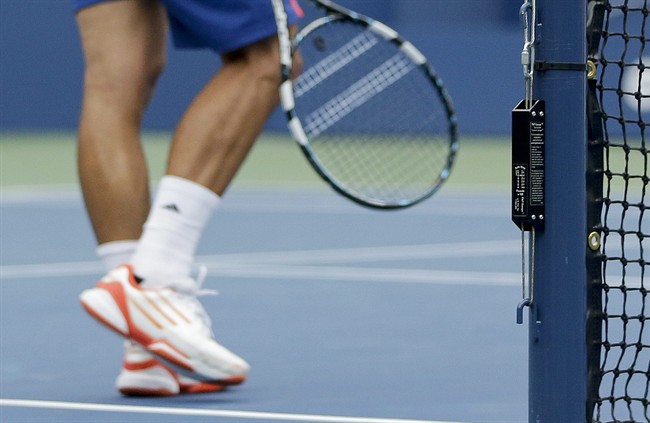US Open using American engineer’s invention to measure net cord tension in tennis matches
Advertisement
Read this article for free:
or
Already have an account? Log in here »
To continue reading, please subscribe:
Monthly Digital Subscription
$0 for the first 4 weeks*
- Enjoy unlimited reading on winnipegfreepress.com
- Read the E-Edition, our digital replica newspaper
- Access News Break, our award-winning app
- Play interactive puzzles
*No charge for 4 weeks then price increases to the regular rate of $19.00 plus GST every four weeks. Offer available to new and qualified returning subscribers only. Cancel any time.
Monthly Digital Subscription
$4.75/week*
- Enjoy unlimited reading on winnipegfreepress.com
- Read the E-Edition, our digital replica newspaper
- Access News Break, our award-winning app
- Play interactive puzzles
*Billed as $19 plus GST every four weeks. Cancel any time.
To continue reading, please subscribe:
Add Free Press access to your Brandon Sun subscription for only an additional
$1 for the first 4 weeks*
*Your next subscription payment will increase by $1.00 and you will be charged $16.99 plus GST for four weeks. After four weeks, your payment will increase to $23.99 plus GST every four weeks.
Read unlimited articles for free today:
or
Already have an account? Log in here »
Hey there, time traveller!
This article was published 05/09/2012 (4824 days ago), so information in it may no longer be current.
KNOXVILLE, Tenn. – The U.S. Open represents a showcase for a tennis invention that measures net cord tension.
David Glass, an engineer from Knoxville with product development experience, received a patent for his TNT Gauge system in November 2010. The device, about 7 inches long and 1 1/4 inches wide, goes on the anchor hook on the outside of a net post. Glass, an amateur tennis player, believes his device can provide consistency in net tension.
“Wimbledon is notorious for very loose nets,” Glass said. “The U.S. Open nets were so tight the ball could bounce very high or completely out of bounds. There was an inconsistency in the game.”

After experimenting with Glass’ device on two outer courts a year ago, the U.S. Open is using it on all its courts this year.
Glass originally had developed a gauge to adjust the tension in the cables of an airplane when he realized the claims on his patent were broad enough to cover sports net tension as well. That’s when Glass realized his idea also could help him out on the tennis court.
“Over the years, I was the guy who had a crescent wrench in my tennis bag,” Glass said. “If I came to a league match or a tournament match where the net felt like it was too loose to be playable, I was the one tightening the net. I didn’t know how tight to make it, but I knew I didn’t like nets that loose.”
Glass, a University of Tennessee graduate, developed the gauge at his alma mater’s tennis centre with the co-operation of the Volunteers’ tennis program. The gauge was initially tested in 2011 during Tennessee’s regular-season matches and an NCAA regional tournament in Knoxville.
“It’s an incredible invention,” Tennessee men’s tennis coach Sam Winterbotham said. “I’m hoping that it’s adopted worldwide because it just adds that consistency. Balls do hit the net. If the ball’s consistently going to hit the net and bounce off the net in the same manner on every court that’s played on, that’s only helpful to the game.”
Use of the gauge expanded later that year to four World Team Tennis sites and five U.S. Open Series events, including a Masters Series tournament in Cincinnati. This year, the gauge was used throughout the NCAA tournament at the University of Georgia. The Rogers Cup WTA and Masters Series events in Canada also utilized the gauge, which takes less than five minutes to install. The U.S. Open is the most high-profile event to use Glass’ device.
“We try to be as consistent as we can in all areas,” U.S. Open referee Brian Earley said. “We document very carefully the court resurfacing process so if possible we get the courts to play the same speed. That’s a big variable as well. The balls we very carefully standardize in terms of manufacture and delivery dates. Anything that we can use that will provide consistency gives us one less variable.”
Glass said the gauge soon will be tested at All-England Club as officials there explore whether to use it at the Wimbledon championships. Glass is hoping the gauge’s increased visibility will cause more local clubs to try it out. His invention currently is being used in more professional venues than local clubs.
“We originally thought this thing would start more at the grass-roots or club level and be popular with club players and work its way upward from there,” Glass said. “It turned out to be exactly the opposite. Pro tennis bought into it quickly, and the clubs are beginning to follow.”
If the clubs continue following suit, Glass finally may be able to remove that wrench from his bag.


